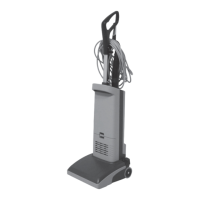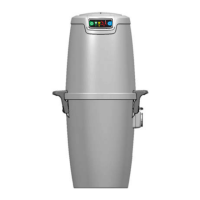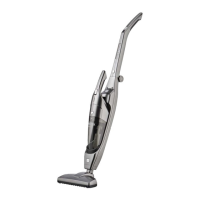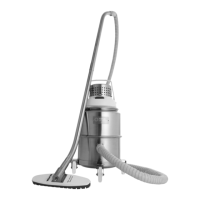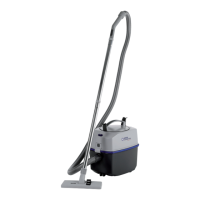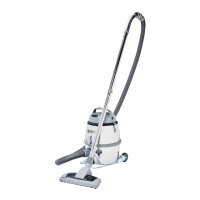C72
8
05/2008
127 / 137
GB
RUS
Before emptying the con tain er it is a advisable to clean -
the fi lter (see “Shaking the main fi l ter” sect.).
Normal version, not suitable for treating hazardous a)
dust
Release the container “I” (fi g. 9), then remove and -
empty it.
Make sure that the seal is in perfect condition and cor- -
rect ly positioned.
Place the container back in po si tion and use the lever -
to secure it again.
Plastic liner
A plastic liner (our code 40100) can be used to collect dust
(see fi g. 9).
In this case, the machine must be equipped with optional
ac ces so ries (grill and depressor - fi g. 9).
Versions for dusts that are hazardous for the health.b)
Classes M - H, suitable for vacuuming hazardous and/
or carcinogenic dust.
ATTENTION DANGER !
In compliance with current laws, these operations -
can only be carried out by trained and specialized
personnel who must wear adequate clothing.
Take care not to raise the dust during this operation. -
Wear a P3 protective mask.
A plastic liner can be used (our code 40100) or ABS -
safety container (our code 8 30202 - 8 31685) if dust
that is dangerous and/or haz ard ous for the health
must be removed.
The container and/or liner must only be disposed -
of by trained personnel and in com pli ance with the
cur rent laws in force.
How to replace the safety container
Place the hose in a safe, dust-free place; -
Release the dusts container “I” (fi g. 10); -
Close the safety container with the supplied cover and -
remove it from the dusts container “I” (fi g. 10). Fit an
empty container in its place.
Start the motor again to pre vent dust from being blown -
about.
Make sure that the seal is in perfect condition and cor- -
rect ly positioned.
Switch off the motor, fi t an empty drum in place and -
fas ten it in position.
Use as a wet cleaner
Make sure that the vacuum clean er is equipped with a
fl oat (liquid level sensor) and is suit a ble for use as a wet
cleaner.
Do not clean up fl ammable liq uids.
If foam forms, stop work im me di ate ly and empty the con-
tainer.
The fi lter element will be wet after liquids have been cleaned
up.
A wet fi lter element can quickly become clogged if the vacuum
cleaner is then used to clean up dry substances.
For this reason, make sure that the fi lter element is dry or
re place it with another one before using the vacuum clean er
to clean up dry materials.
At the end of a clean ing session -
Turn off the vacuum cleaner and remove the plug from 1-
the socket.
Coil the connection fl ex (fi g. 11).2-
Empty the container as de scribed in the “Emptying 3-
the container” section. Clean the vacuum cleaner as
described in the “Main te nance, cleaning and de con-
tam i na tion” section.
Wash the container with clean wa ter if aggressive sub-4-
stanc es have been cleaned up.
Store the vacuum in a dry place, out of the reach of 5-
un au thor ized people.
Shut the inlet with the ap pro pri ate plug “A” (fi g. 11) when 6-
the vac u um cleaner is trans port ed or not being used
(par tic u lar ly in the case of versions M - H).
Maintenance, clean ing and de con tam i na- -
tion
ATTENTION DANGER !
Note: the precautions de scribed below must be tak en
during all the main te nance operations, in clud ing clea-
ning and re plac ing the main and Hepa fi lters.
To allow the user to carry out the maintenance op er a-a)
tions, the vacuum must be disassembled, cleaned
and over hauled as far as is rea son a bly pos si ble,
without caus ing haz ards for the maintenance staff
or other people.
The suit a ble pre cau tions in clude de con tam i na tion
before dis as sem bling the vac u um, ad e quate fi ltered
ven ti la tion for the air ex haust ed from the room in
which it is dis as sem bled, clean ing of the main te nance
area and suitable personal pro tec tion.

